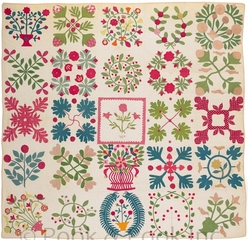 Quilts are some of the most ubiquitous antiques – made for generations, still made, sometimes in the same ways, and still being sold or handed down in families. And perhaps more than many objects, they’re often completely detached from their history – no provenance, no history of a maker – and thus are reduced just to condition and whatever details can be drawn out from the age of the fabric, the pattern, and the technique.
Quilts are some of the most ubiquitous antiques – made for generations, still made, sometimes in the same ways, and still being sold or handed down in families. And perhaps more than many objects, they’re often completely detached from their history – no provenance, no history of a maker – and thus are reduced just to condition and whatever details can be drawn out from the age of the fabric, the pattern, and the technique.
For this reason, history can make a great difference in prices. A quilt like this one, which descended in an early Virginia/West Virginia family with family provenance, fetched easily three times what it likely would have as just an “old quilt” with no specific origins. Friendship quilts were also popular and help researchers make genealogical and historical connections. Friendship quilts are typically quilts with a traditional pieced structure, but they are often signed (and the pieced pattern often incorporates a “clear” white space for a signature and/or an embroidered inscription). Tradition indicates that friends would each make a pieced section to contribute.
A better documented, if more isolated tradition is that of the Baltimore album quilt. Album quilts (like the one pictured above) appeared in the 1840s in the Baltimore area (eventually spreading to other regions, including documented examples in the Miami River Valley area of Ohio), and unlike more traditional quilts which are made up of pieces of the same composition stitched together to create a pattern, album quilts are typically comprised of larger individual blocks, all with a separate design, style, or motif. While they were later often sold in kit form, early ones were individually designed, and while they occasionally appear to have been made by one person, the majority – and the most desirable – album quilts were, instead, often made by a group of women with each contributing a block that was either designed by the future owner or that was designed by the individual contributor. Oftentimes, the blocks are also signed by the makers, either in indelible ink or embroidery. The genealogical gift of more than one name (and, frequently, a date) is a great one to researchers.
Both friendship and album quilts were periodically also made for very specific occasions or causes, to commemorate weddings, birthdays, or other milestone events. While it appears to have been done all in one hand, this quilt, for example, marks Ohio’s contribution to the Civil War, being presented in 1884 to the mother of a soldier and listing the names, companies, and regiments of around 300 Ohio soldiers. So many quilts probably carry great stories, and the marketplace definitely appreciates those still in a position to “speak up”!



